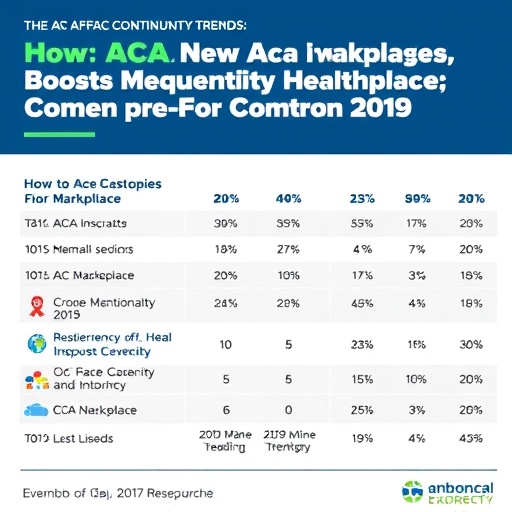In a landmark study released in 2025, researchers Barbara Rubino and Soni M. Soni explore how the Affordable Care Act (ACA) Marketplace is making significant strides in enhancing the continuity of health care for millions of Americans. The study, published in the Journal of General Internal Medicine, sheds light on the critical elements that contribute to this improvement. As health care systems worldwide face unprecedented challenges, understanding how effective policy frameworks can make a difference is essential. The findings of Rubino and Soni not only underline the benefits of the ACA Marketplace but also provide insights for future policy directions.
The ACA Marketplace aims to provide a platform where individuals can compare and purchase health insurance plans while receiving financial assistance based on their income levels. This has been particularly beneficial for those who previously found themselves uninsured or underinsured. By creating an environment that prioritizes access and affordability, the ACA Marketplace sets a precedent for how public policy can directly influence health care continuity. It is crucial to understand how such structured marketplaces can reduce gaps in coverage while enhancing health outcomes for vulnerable populations.
One of the key takeaways from the research is the increasing enrollment rates observed in states that have fully embraced the ACA Marketplace. Prior to the act’s implementation, individuals in these states faced significant obstacles in accessing necessary care. However, the research indicates that the ACA has played a pivotal role in diminishing these barriers, which is particularly evident in the rising number of individuals maintaining continuous coverage. This change is significant as continuous coverage is a critical component for managing chronic diseases and preventing gaps in treatment.
The study also highlights an important demographic shift. Many young adults, who traditionally lagged in enrolling for health insurance, have shown remarkable engagement with the ACA Marketplace. This demographic trend is essential as it infers a potential shift in health management paradigms. The inclusion of a younger population enhances overall health outcomes and, in the long term, contributes to the stability of the insurance pool. As they age, these individuals are more likely to carry their insurance habits forward, leading to sustained health care engagement.
Health care continuity is distinctly beneficial for managing chronic illnesses, which require consistent monitoring and treatment. Rubino and Soni provide compelling evidence that individuals with chronic conditions who have access to continuous coverage through the ACA Marketplace are experiencing substantially improved health outcomes. The study meticulously details how patients with chronic diseases report higher satisfaction levels, increased access to necessary treatments, and better overall health. This finding is crucial as it reinforces the notion that stable health insurance not only eases financial burdens but also promotes proactive health management.
The team further discusses how the ACA Marketplace has cultivated a sense of security among its consumers. Individuals who know that insurance coverage is consistently available are more likely to seek preventive care and treatment proactively, rather than postponing care until health conditions worsen. This shift towards preventive care is a hallmark of a successful health care system, where the focus is on maintaining the health of the population rather than solely treating illnesses.
One must note, however, that challenges still exist in the realm of health care coverage. While the ACA Marketplace has made considerable strides, certain populations remain underserved. The research identifies minority groups and rural populations as areas requiring continued focus and improvement. Efforts must be made to ensure that these demographics can navigate the complexities of the Marketplace with ease, allowing them the same benefits enjoyed by their urban and majority counterparts.
The authors also touch upon the role of technology in facilitating access to health care information. Digital health platforms are increasingly becoming a lifeline for individuals seeking information about their health insurance options. By leveraging technology, the ACA Marketplace can enhance its outreach efforts, ensuring that potential enrollees are informed and equipped to make choices that best meet their needs. This synergy between technology and policy could serve as a model for health care systems globally.
Moreover, the research emphasizes the importance of public awareness campaigns in the success of the ACA Marketplace. Educating consumers about their rights, options, and the nuances of health insurance is essential for maximizing enrollment and engagement. When individuals are better informed, they can navigate the system more effectively, leading to higher enrollment rates and improved health outcomes.
The findings of Rubino and Soni serve as a potent reminder of the impact that policy intervention can have on public health. The improvements in health care continuity highlighted in this study paint a hopeful picture for the ongoing evolution of health care in America. As we navigate an increasingly complex health landscape, understanding the mechanisms that lead to better health outcomes will remain vital.
In conclusion, the ACA Marketplace has proven to be a robust platform for enhancing health care continuity amidst a background of systemic challenges. The research by Rubino and Soni underscores the necessity of maintaining and improving such marketplaces to ensure their benefits reach all segments of the population. Continuous coverage is not merely a policy goal; it is essential for the health and well-being of individuals and the economy at large. The implications of this study extend beyond the U.S., offering valuable lessons for other nations grappling with similar health care challenges as they work to develop effective public health policies.
Lastly, as the health care system continues to modify in response to the ever-changing landscape of health needs, ongoing research and advocacy will be paramount. The ACA Marketplace serves as a testament to what can be achieved through thoughtful policy design, continual assessment, and active engagement with the communities it serves. As more evidence emerges regarding the need for adaptability in health care systems, the lessons learned from the ACA Marketplace will undoubtedly become indispensable in shaping future health care reforms.
Subject of Research: Affordable Care Act Marketplace and Health Care Continuity
Article Title: How an ACA Marketplace Is Stemming the Slide on Continuity
Article References:
Rubino, B., Soni, S.M. How an ACA Marketplace Is Stemming the Slide on Continuity.
J GEN INTERN MED (2025). https://doi.org/10.1007/s11606-025-10018-6
Image Credits: AI Generated
DOI: https://doi.org/10.1007/s11606-025-10018-6
Keywords: ACA Marketplace, health care continuity, health insurance, public policy, chronic diseases.
Tags: Affordable Care Act Marketplacecomparative health insurance platformsenrollment rates in ACAfinancial assistance for health insurancefuture policy directions for healthcarehealth care systems challengeshealth insurance accessibilityhealthcare continuity trendsimpact of public policy on healthcareimproving health outcomesreducing gaps in health coveragevulnerable populations and healthcare





